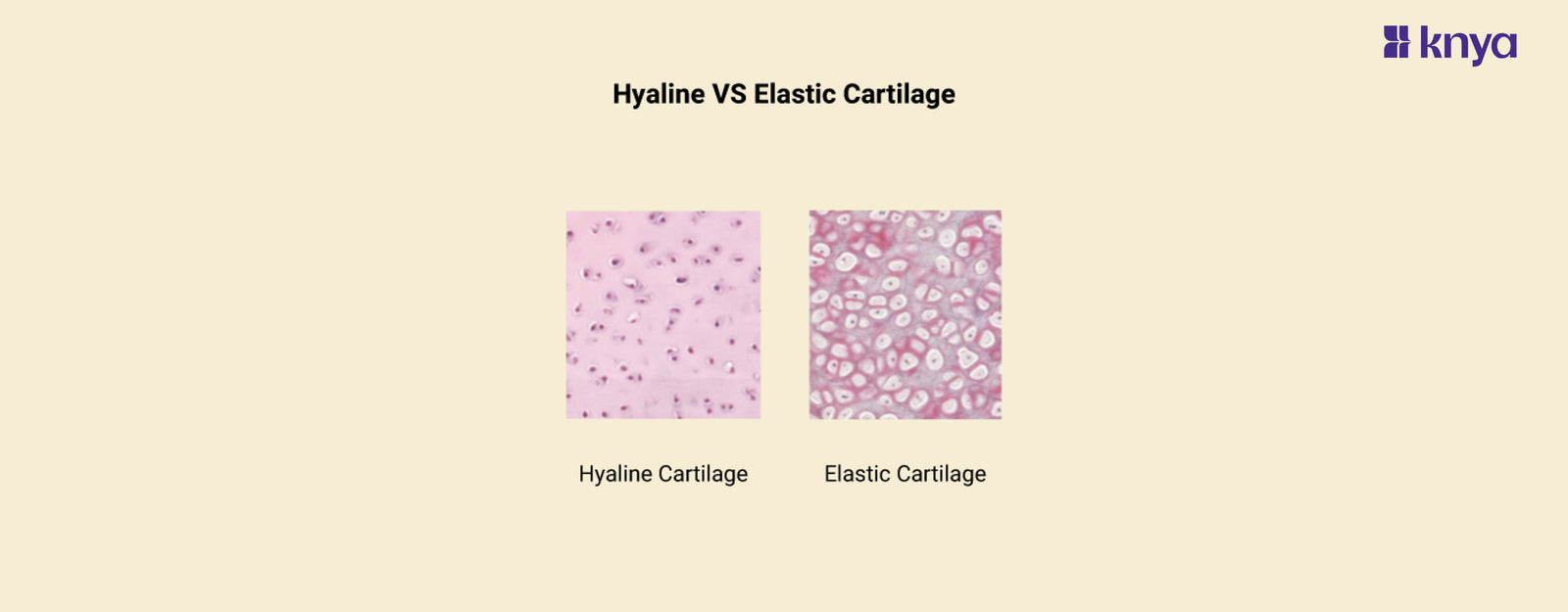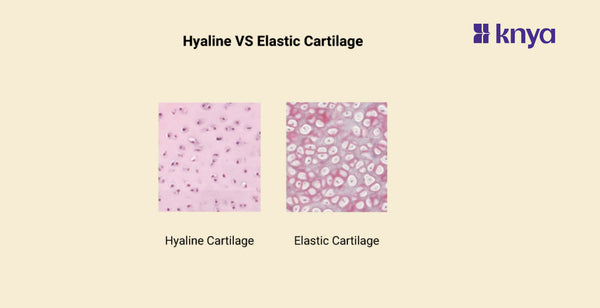Difference Between Hyaline and Elastic Cartilage: Hyaline and Elastic Cartilage are two important types of cartilage in the body, but they differ in their structure, function, and location. Hyaline cartilage, the most abundant type, is known for its smooth, glassy appearance and provides strong yet flexible support for structures that need to bear weight or glide against each other. Examples include the covering of your joints (articular cartilage), the rings that keep your trachea open, and the supportive structures in your nose and ribs. In contrast, elastic cartilage is distinguished by its yellowish color and springy texture due to the presence of abundant elastic fibers. This unique composition allows elastic cartilage to resume its original shape after bending, making it ideal for structures that require flexibility and resilience. Examples include the external ear, which can be bent without collapsing, and the epiglottis, a flap in your throat that helps prevent food from entering your airway.
Difference Between Hyaline and Elastic Cartilage
Hyaline Cartilage and Elastic Cartilage are two types of cartilage tissues found in the human body. They both serve as supportive tissues in various anatomical structures, but they differ in composition, function, and location. Listed Below are the differences between Hyaline and Elastic Cartilage:
|
Feature |
Hyaline Cartilage |
Elastic Cartilage |
|
Composition |
Contains predominantly collagen fibers |
Contains predominantly elastic fibers |
|
Appearance |
Bluish-white, translucent |
Yellowish, more opaque |
|
Function |
Provides support and flexibility |
Provides resilience and flexibility |
|
Location |
Found in joints, ribs, nose, trachea |
Found in external ear, epiglottis, larynx |
|
Elasticity |
Less elastic |
Highly elastic |
|
Strength |
More rigid and less flexible |
More flexible and resilient |
|
Shape retention |
Maintains shape well |
Maintains shape even under distortion |
|
Regeneration |
Limited ability to regenerate |
Limited ability to regenerate |
|
Collagen Type |
Type II collagen |
Contains both type II and type III collagen |
|
Chondrocyte Function |
Responsible for cartilage matrix maintenance |
Produce more elastic fibers |
Order the Best Jogger Scrub from Here!
What is Hyaline Cartilage?
Hyaline cartilage makes up the majority of the body's cartilage. It creates smooth, shimmering surfaces at joints, allowing bones to slide over one another with little friction. It is also present in the nose, trachea, and ribs. Hyaline cartilage is strong but flexible, with no blood vessels or nerves.
Browse Best Scrubs Collection
Key Features of Hyaline Cartilage:
- Hyaline cartilage is a textbook example, appearing in a variety of tissues across the body. It gives sturdy support with a smooth, glassy look (thus the name "hyaline," which means glass-like).
- The extensive extracellular matrix is the main feature of hyaline cartilage. This thick network of fibres, mostly made of type II collagen, offers great durability and keeps the cartilage in form.
- Hyaline cartilage, unlike other tissues, does not have blood vessels or nerves. This makes it smooth and frictionless, ideal for gliding joints. However, a shortage of blood vessels results in delayed recovery times for injuries.
- Despite the lack of blood arteries, hyaline cartilage relies on diffusion for nutrition. Nutrients from adjacent tissues permeate the cartilage, giving the chondrocytes (cartilage cells) with what they require for survival.
What is Elastic Cartilage?
Elastic cartilage is far less prevalent than hyaline cartilage. It is yellowish and springy because it contains a large number of elastic fibres. This unusual structure allows elastic cartilage to return to its original form after bending or twisting. Elastic cartilage is present in the external ear, the eustachian tube, and some portions of the larynx.
Explore All Women's Scrub
Key Features of Elastic Cartilage:
- Elastic cartilage is known for its elasticity. It can bend and deform without breaking due to the abundance of elastic fibres woven throughout its extracellular matrix, together with collagen fibres.
- This elastic feature makes it perfect for structures such as the external ear, where it retains form while allowing for some bending. It is also present in the epiglottis (throat cartilage) and sections of the larynx (voice box), where flexibility is beneficial in a variety of activities.
- Elastic cartilage has somewhat more chondrocytes than hyaline cartilage. These cells play an important role in tissue maintenance and matrix production.
- Elastic cartilage, like hyaline cartilage, lacks blood vessels and cells. It receives nutrients by diffusion from neighbouring tissues, limiting its healing ability.
Shop Best Lab Coats from Here!
Similarities Between Hyaline and Elastic Cartilage
- Both forms of cartilage have chondrocytes as the principal cell type in charge of maintaining the extracellular matrix.
- Both have an extracellular matrix that protects and strengthens the chondrocytes.
- Blood arteries are absent from both hyaline and elastic cartilage, therefore nutrition exchange occurs by diffusion.
- Both forms of cartilage can resist certain mechanical stress.
- Both forms of cartilage function as supporting tissues, giving shape and structure to different sections of the body.
While both hyaline and elastic cartilage provide structural support, they have quite different compositions and functions. The most common variety of cartilage is hyaline, which has a smooth, glassy look due to the quantity of collagen fibres. It functions as a stress absorber in joints such as the knees and plays an important role in bone formation by generating the first template. Elastic cartilage, identified by its yellowish tone and springy texture, is densely packed with elastic fibres. This distinctive constitution enables structures such as the external ear to retain their form while bending without breaking. The distinction between hyaline and elastic cartilage reflects their respective roles in the body.
| Check out More Articles | |
| Difference Between Cartilage And Bone | |
| Difference Between Endocrine And Exocrine Glands | |
| Difference Between Cell Wall And Cell Membrane | |















